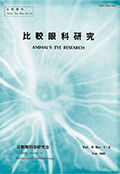Volume 9, Issue 1-2
Displaying 1-10 of 10 articles from this issue
- |<
- <
- 1
- >
- >|
Lectures and Reports at gth Symposium on Some Problems in the Field of Comparative Ophthalmology
Special Lectures
-
1990Volume 9Issue 1-2 Pages 1-14
Published: 1990
Released on J-STAGE: December 25, 2020
Download PDF (4029K) -
1990Volume 9Issue 1-2 Pages 15-23
Published: 1990
Released on J-STAGE: December 25, 2020
Download PDF (2821K)
Reports
-
1990Volume 9Issue 1-2 Pages 25-30
Published: 1990
Released on J-STAGE: December 25, 2020
Download PDF (1949K) -
1990Volume 9Issue 1-2 Pages 33-38
Published: 1990
Released on J-STAGE: December 25, 2020
Download PDF (1994K)
Poster Session
-
1990Volume 9Issue 1-2 Pages 41-42
Published: 1990
Released on J-STAGE: December 25, 2020
Download PDF (639K) -
1990Volume 9Issue 1-2 Pages 45-46
Published: 1990
Released on J-STAGE: December 25, 2020
Download PDF (853K) -
1990Volume 9Issue 1-2 Pages 49-50
Published: 1990
Released on J-STAGE: December 25, 2020
Download PDF (609K) -
1990Volume 9Issue 1-2 Pages 51-54
Published: 1990
Released on J-STAGE: December 25, 2020
Download PDF (1332K) -
1990Volume 9Issue 1-2 Pages 59-60
Published: 1990
Released on J-STAGE: December 25, 2020
Download PDF (818K)
Original Report
-
1990Volume 9Issue 1-2 Pages 63-68
Published: 1990
Released on J-STAGE: December 25, 2020
Download PDF (1810K)
- |<
- <
- 1
- >
- >|
